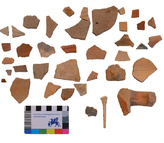Plan: The adaption of the great E Basilica of Khirbet Yājūz by the Islamic religion cannot be proven compellingly so far, but is to a high degree probable. The Christian church is a three-aisled building of basilical plan with an apse and protesis in the E. A carefully paved atrium with a cistern adjacent in the W, which is surrounded by various rooms. According to field research in 2016/2015, this was obviously in origin a pagan Nabataean/Roman sanctuary in N-S orientation, and the Byzantine church has been added in a later phase reusing many decorative elements of this pagan shrine which had the character of a High-Place sanctuary at the highest point of the topography (Fig. 462.2). In the SW corner of the atrium, a staircase gives access to a crypt located at a lower level than the church and consisting of a natural cave. The naós of the basilica is divided by two colonnades into three aisles, accessible by three gates in axis in the W wall.
Measurements: ca. 405 m2 (basilica alone); 418 m2 (atrium)
Exterior: 15 x 27 m (basilica alone); 22 x 19 m (atrium alone)
Interior: unknown.
Building Materials: Local light brown limestone with a large number of spolia from the pagan sanctuary: Corinthian composite capitals with small divine busts below the abacus (figs. 462. 5-6); associated with column drums on Attic-Ionic bases (fig. 462.9) for the two colonnades of the basilica; a monolithic door lintel with the representation of garlands, grapes, a squatting eagle, a horned altar and paterae (fig. 462.5), a frieze more than 7 m long with the representation of a vegetal scroll with jumping animals (fig. 462.4), garland block with rosette (fig. 462.6) and five altars (figs. 462.57-81). Two late Hellenistic Ionic capitals as well as the scallop tondo of a niche are found as spolia in the area of the pagan temple / atrium.
Preservation: The DoA has been alerted by the demolishment of the basilica in 1994 when the landowner removed the N colonnade of the basilica by bulldozer and destroyed the major part of the mosaic floor in front of the presbytery. Subsequent rescue work were conducted by the DoA under the supervision of E. Sulayman between 1994 and 1998. In 1998, the Khirbet Yajuz excavation and restoration project was transferred to Professor Dr. Lutfi A. Khalil as a trainee-program for students of the University of Jordan. In the years after, various probe soundings and meritful consolidation work has been undertaken bei the University of Jordan summer-course teams.
Inscription(s): A number of column drums and bases show offset marks in the shapes of Greek letters in their adjoining surfaces (cf. fig. 436.9). Beside Greek letters, which can be interpreted as numerals, also the swastika appears one time. It is very likely that these marks were set by the producers of these architectural elements to give hints to the constructors for a correct arrangement. Apart from that, in the basilica several stones with a tabula ansata have been found, the tables of which were erased by a zig-zag comb hatching.
From the area of the qaṣr (Fig. 462.1 no. 4), to the E of the basilica comes, the fragment of an inscribed limestone pedestal (1) for a votive statue of an eagle (cf. also fig. 436.85). It has been used as a spoil in the Byzantine weavery and certainly belongs to the cultic pagain furniture of the basilica context. The stone is conserved today in the general storage of the DoA at Ṭabarbūr. On the front of the pedestal is a votive inscription incised in Greek over three line. In the first reading published E. Suleiman (1999) proposed an address of the ex voto to the Olympian Zeus Δ(ιὶ) Ο(λυμπίῳ) as the begin of the first line. The following reading communicated by P.-L. Gatier, however, is preferable: (facsimile drawing with the hypothetic reconstruction of the squatting eagle by Munjad Qasem, University of Jordan, photo by TMW-K 2016):











































